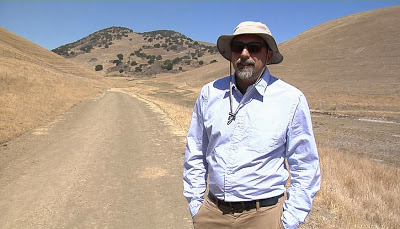
Data received from seismic monitoring stations coupled with information rapidly shared via smartphones and the Internet by those who experienced the south Napa temblor is serving to advance scientists’ understanding of earthquakes as well as improving rapid response, according to Artie Rodgers of the Lab’s Seismology Group and Geophysical Monitoring Program.
Rodgers recently provided a summary of what has been learned so far from the event in a presentation entitled, “The Aug. 24 South Napa Earthquake: What Is Known So Far, Accessing Open Information and Preliminary Ground Motion Simulations.”
The 6.0 magnitude earthquake that ruptured a 12-kilometer stretch of the West Napa Fault at 3:20 a.m. on Aug. 24 was the largest “event” in the Bay Area since the Loma Prieta earthquake of October 1989. So far, one fatality and 100 injuries and more than $100 million in damage has resulted from the Napa quake.
“This event tested real-time monitoring and rapid response,” Rodgers said. “The Napa quake was large enough to cause widespread damage, especially to unreinforced masonry buildings; but nowhere near the devastation that would be expected from a magnitude 7 quake along the Hayward, Rodgers Creek or San Andreas faults.”
A new source of data for seismic researchers is information received from people who sent out messages using their smartphones or using the Internet in the minutes following the quake. “Crowd sourcing and apps for smartphones offer new ways to understand the impact of quakes in specific areas and that’s really exciting,” Rodgers said. “There’s so much data out there that we can take advantage of.” Emergency responders used this information to rapidly identify areas to search for damage while researchers sought evidence of the earthquake rupture and deployed instruments.
The United States Geological Survey (USGS) collects information on a website called “Did You Feel It?” The idea, according to the website, is to “tap the abundant information available about earthquakes from the people who actually experience them” in near real time. Information provided contributes to the scientific body of information about the effects of an earthquake. USGS provides a number of open information resources about earthquakes on its Web pages.
The Napa event served to underscore that “engineering, building design and construction practices really matter,” Rodgers said.
By way of example, he compared the damage from the Napa event with the Aug. 3 magnitude 6.1 Ludian shaker in Yunnan, China, where 619 people died and 25,800 homes were destroyed. There was one fatality in Napa and far fewer homes were lost.
This is of particular importance in the San Francisco Bay Area where, the USGS and others believe, there is a 63 percent chance for one or more magnitude 6.7 or greater earthquakes between 2007 and 2036, with the Hayward and Rodgers Creek faults being the most likely locations.
The Napa event also served as a test for the Earthquake Early Warning (EEW) system. An earthquake fault rupture sends out different types of motion waves with fast moving P-waves arriving first, followed by the slower but more damaging S-waves and later surface waves, Rodgers explained. Sensors detect the P-waves and transmit data to an earthquake alert center where the location and size of the event are determined and updated as more data becomes available. The alert center then sends out warnings before damaging S- and surface waves arrive.
Rodgers said that the first P-waves detected and transmitted by sensors in Napa provided the alert center in Berkeley with five seconds advance notice. “Five seconds may not sound like much,” he said. “But it can be enough time to shelter or to exit a building.”
“The early warning worked well for the South Napa earthquake,” Rodgers said. “Improvements to the seismic sensor network will make the early warning system even better.”
Recalling the 5.8 magnitude Livermore earthquake along the Greenville Fault in 1980 that caused $10 million in damage, Rodgers suggested the local area would benefit from an expanded early warning system.
Early warnings also could be improved by tapping data from ubiquitous mobile phones, and the Berkeley Seismological Laboratory has even developed a “MyQuake” app.
Earthquake data is collected in a variety of ways including: GPS stations, which observe very precise pointwise geodetic displacements; satellites using interferometric synthetic aperture radar (InSAR); and radar systems carried aboard airplanes allow a timely and detailed view of major events.
The vast quantities of data collected from the Napa quake also help determine details of the rupture and to validate and hopefully refine the three-dimensional (3D) subsurface structure using simulations run on LLNL High Performance Computing (HPC) systems. Seismic simulations allow scientists to better understand the distribution of shaking and damage that can accompany earthquakes, including possible future-scenario earthquakes.
Lawrence Livermore’s Anders Petersson and Bjorn Sjogreen have developed the Seismic Wave 4th order (SW4) code, which is enabling some of the most detailed, and realistic seismic simulations yet conducted. They’ve run simulations on the Vulcan supercomputer evaluating different scenarios on the 70-mile long, 9-mile deep Hayward Fault, evaluating the “intensity” of shaking.
Intensity, measured using the Modified Mercalli Intensity scale, is a qualitative way to measure the strength of ground shaking at a particular location. Typically, intensity is greatest near the earthquake epicenter. It should not be confused with “magnitude,” measured by a seismograph using the Richter scale, which relates to the energy released by an earthquake.
Coincidentally, Petersson presented his latest work on SW4 in a seminar just three days before the Napa earthquake struck. The complexity of surface and subsurface earth features, particularly almost incompressible materials such as clay, make accurately modeling wave propagation a challenge, he told scientists in attendance.
Rodgers has used the recent event data collected from Napa to run simulations on the Lab’s Cab supercomputer, a 430-teraflop Intel system, notably modeling observed broadband earthquake waves that cause damage to manmade structures. While models need further refinement, he said the Napa earthquake “provided validation data to evaluate current capabilities for ground motion predictions.”
Studying the effects of earthquakes on manmade structures, particularly in a place as urbanized as the Bay Area, allows people to better prepare for the next one. “We can’t stop earthquakes,” Rodgers said. “But we can certainly make our experience of them safer.”
Note : The above story is based on materials provided by Lawrence Livermore National Laboratory










